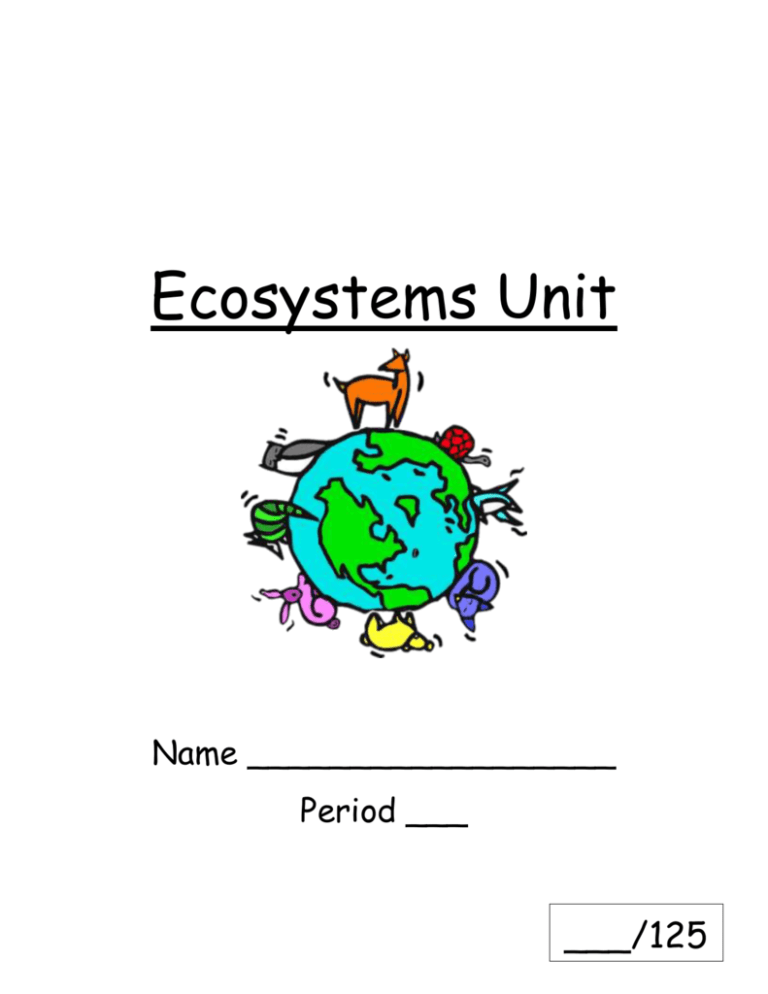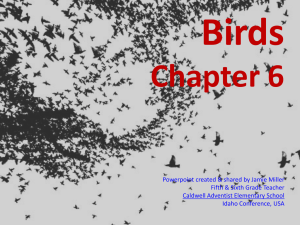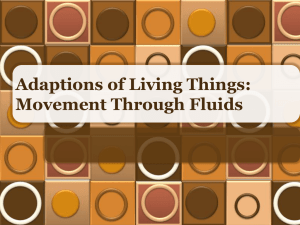1 point - Brandywine School District
advertisement

Ecosystems Unit Name __________________ Period ___ ___/125 Key Learning: All living and nonliving things on our planet are connected. Unit Essential Question: How are the living and nonliving things connected in an ecosystem? Concept: Energy Flow In Concept: and Function An Ecosystem Interactions Lesson Essential Lesson Essential Lesson Essential Questions: Questions: Questions: 1. How are population sizes determined? 1. How do adaptations increase an organism’s chance of survival? 1. How do I describe the flow of energy through an ecosystem? 2. How do limiting factors affect the carrying capacity of an environment? 2. How do I know how much energy I am receiving when I eat different foods? Concept: What’s In Concept: An Ecosystem? 2. How do you identify what is in an ecosystem? Structure Among Organisms Lesson Essential Questions: 3. How does the structure affect the function of an organism? 1. How do I describe the relationship between organisms in an ecosystem? 2. How do I display the interactions among organisms in an ecosystem? Vocabulary: Vocabulary: Vocabulary: Vocabulary: Population Dichotomous Key Trophic Level Food Chain Sampling Structure Autotrophs Food Web Abiotic Factor Function Heterotrophs Symbiosis Producers/Consumers Commensalism Herbivore/Carnivore/Omnivore Mutualism Decomposers Parasitism Biotic Factor 1 Population Sampling Directions: In your groups, complete the diagram below and answer the questions at the bottom. (10 points) 1. How would you go about figuring out the number of students at Talley without counting each student or looking it up on the computer? ___________________________________________________________________________________ ___________________________________________________________________________________ 2. Grass is a living organism and there is lots of it. How would you go about counting how many blades of grass are on the field inside the track? ___________________________________________________________________________________ ___________________________________________________________________________________ 2 __/10 Investigation #1: Sampling Populations Directions: Complete the following investigation in your groups. Be sure to complete each step in sequence. Then answer the reflection questions. (15 points) Materials: 1 paper cup with approximately 5 ounces of dry beans 1 measuring cup 2-18 inch pieces of string Procedure/Data: Pretend that the beans you measure out are a flock of shorebirds. Follow your teacher’s directions to try and “count the birds”. Record your answers below. 1. You will work in your group. Each bean represents a bird. Together, guess how many bean-birds are in the paper cup. Do not count the beans individually! Record your paper cup estimate on the data sheet. How many birds do you guess are in your cup? (1 point) _________________ 2. Spread the beans on your desktop in an area no larger than 12-18 inches square. Your desktop represents the beach. 3. Observe the bird-beans on the desktop-beach. Without touching the beans, visually try to divide the beans into groups with 5 beans in each group. How many groups of five beans in each group do you estimate? (1 point) _______________ Multiply the number of groups by 5 beans in each group and record the number of “groups of 5” estimate: (1 point) ____________________ 4. Observe the beans again. Visually, try to divide the “flock” into four equal sections. Lay the two pieces of string across the flock to divide the flock into four sections of equal area. 3 5. Count all the birds in one section (square). How many birds are in one (of the four) section? (1 point) ______________ Multiply the answer to by 4. (1 point) ___________________ 6. Count the number of birds in the other 3 sections and add then together to get the total number of birds: (1 point) __________ + __________ + __________ + __________ = __________________ (Total number of birds) 7. How far off was your guess (answer to #1)? (1 point) _____________________ Investigation Reflection: 1. Which estimate was closer to the actual number of birds? Was it the paper cup estimate, the “groups of 5” estimate, or the four sections estimate? (2 points) ______________________________________ 2. Without asking other groups for the number of bird-beans they have, how could you determine the number of bird-beans in the entire class? (2 points) ___________________________________________________________________ ___________________________________________________________________ 3. Describe how biologists estimate flocks of shorebirds. (1 point) ___________________________________________________________________ ___________________________________________________________________ 4. Why is population sampling important? (1 point) ___________________________________________________________________ ___________________________________________________________________ 5. What are some of the reasons for a decrease or increase in populations? (2 points) Decrease:____________________________________________________________ Increase:____________________________________________________________ 4 __/15 Evolving Beaks – Evolution and Adaptation Directions: Answer the following questions using the slideshow, discussions, and video. (15 points) 1. What is natural selection? Give an example of natural selection in the video. (2 points) ___________________________________________________________________ ___________________________________________________________________ ___________________________________________________________________ 2. Environmental stresses could be… (5 points) ___________________________________________________________________ ___________________________________________________________________ ___________________________________________________________________ 3. …and can cause a species to… (3 points) ___________________________________ ___________________________________ ___________________________________ 4. Since being on the Galapagos, species have evolved from their original ancestors and show structural differences. (For example, some lizards have developed shorter tails so they can run faster). Pick two of the species mentioned in the video and explain how each has evolved from their original ancestors. (4 points) ___________________________________________________________________ ___________________________________________________________________ ___________________________________________________________________ ___________________________________________________________________ 5. The point of life is to (1 point) __________________________________________ 5 __/15 What the Beak? Part A: Brainstorming Bird Adaptations in General Bird Adaptations: General Background General Bird Adaptations 1. Feathers are a unique adaptation found only in birds. Two kinds of feathers are found on all birds: Down feathers are for insulation and contour feathers are the strong outer feathers used for flight. They are also the bird’s coloration. Feathers are an adaptation used to help birds survive temperature extremes. 2. Hollow bones help keep the bird’s weight low. Most of the bird’s weight is in the breast and wings (where flight muscles are). 3. Air sacs enable a bird to take in enough oxygen to help transform energy into a usable form for flight. Birds have lungs like humans, but they require more oxygen intake. Air sacs, rather like balloons, extend from the lungs. During inhalation and exhalation, air flows through the lung and the air sacs to maximize the absorption of oxygen. Specific Shorebird Adaptations 1. Long, pointed wings for long distant flight. This adaptation enables the shorebirds to fly fast and far. 2. Camouflage plumage serves as protection. 3. Long legs are suited for walking along the shoreline or mud and help in food gathering. 4. Long toes for stability and walking. 5. Bills, or beaks, are used for picking up food, nest construction, and courtship as well as preening and defense. 6. Oil gland helps keep a shorebird’s feathers waterproof. 6 Environmental Concerns 1. Habitat disturbance can occur during migration preventing birds from stopping at their traditional stopovers to refuel. 2. Pollution such as plastic debris, fishing line and runoff can degrade shorebird habitat. 3. Habitat destruction. After reading, brainstorm within your groups to answer the following questions: 1. Name 3 adaptations specific to all birds. (3 points) _________________________________________ _________________________________________ _________________________________________ 2. What type of adaptations do shorebirds have to help them survive? (2 points) ___________________________________________________________________ ___________________________________________________________________ ___________________________________________________________________ 3. What advantage would these adaptations provide the shorebird as compared to nonshorebirds attempting to survive in a near shore environment? (3 points) ___________________________________________________________________ ___________________________________________________________________ ___________________________________________________________________ 4. What do shorebirds eat? (2 points) ___________________________________________________________________ ___________________________________________________________________ ___________________________________________________________________ __/10 7 Part B: Modeling Beak Adaptations Mr. Herlihy will give you instructions on materials to collect as well as what procedure to follow. Record your groups’ data in the table provided. 1. Mr. Herlihy has constructed a “feeding area” for your diverse population of shorebirds. Pipe cleaners = worms washers = crustaceans Marbles = snails puffed rice = horseshoe crab eggs 2. Your group will be given a cup. The cup represents your bird’s stomach. Place food obtained from the feeding area in the cup (stomach). The cup may not be used to gather food. 3. Mr. Herlihy will give each group tweezers, scissors, a spoon, and a clothespin. Each tool represents a different kind of bird beak, allowing the bird to obtain food (See chart below). 4. Using one utensil at a time, you will simulate a bird feeding. Mr. Herlihy will provide you with one minute in which to obtain food using this utensil. The first round will be practice so that you figure out what food items are easiest for you to “eat.” 5. Now simulate all of the birds feeding at the same time again. This time you will record the food you “eat.” 6. Create bar graphs to compare the individual feeding data to the competition data when all birds were feeding at the same time. 7. Compare how effective each beak type was in a competition scenario. Discuss results. Data Table: (8 points) 8 Graph: (10 points total) 9 Investigation Reflection: 1. How are different beaks adapted to feed on a specific type of food? (2 points) ___________________________________________________________________ ___________________________________________________________________ ___________________________________________________________________ 2. What types of beak adaptations are best suited for shorebirds? (1 point) ___________________________________________________________________ ___________________________________________________________________ ___________________________________________________________________ 3. How does the size of the population (number of birds feeding) and the size of the feeding areas affect how much food is consumed? (2 points) ___________________________________________________________________ ___________________________________________________________________ ___________________________________________________________________ 4. Which bird has the most efficient beak (easiest for gathering food)? Use evidence to explain your answer. (2 points) ___________________________________________________________________ ___________________________________________________________________ ___________________________________________________________________ 10 __/25 Structure/Function Lab Directions: There are 5 stations set up around the room. You will spend 5 minutes at each station completing the following table. (20 points) Organism Structure & Function Environment Advantage __/20 11 Energy Flow Through an Ecosystem Directions: Answer the following questions during our discussion (30 Points) 1. Where does the energy in an ecosystem originate? (1 point) _____________________ 2. How do plants and animals have a symbiotic relationship? Be specific. (2 points) ___________________________________________________________________ ___________________________________________________________________ 3. What happens to the energy that producers make during photosynthesis? (2 points) ___________________________________________________________________ ___________________________________________________________________ 4. Consumers that eat producers are… (2 points) ________________________________________ ________________________________________ 5. What happens to the energy the primary consumer gets from the producer? (3 points) ___________________________________________________________________ ___________________________________________________________________ 6. A consumer that eats another consumer for energy… (4 points) ________________________________________ ________________________________________ ________________________________________ ________________________________________ 7. What happened to the energy consumed by the secondary consumer? (3 points) ___________________________________________________________________ ___________________________________________________________________ 8. Humans are examples of ___________________________. (1 point) 12 9. Draw an example of a food chain in the space below. (You may not use the one on the screen except you must start with the Sun). (5 points) 10. Copy the food chain you see on the screen. Be sure to use colors, label, and make a key. (7 points) 13 __/30





